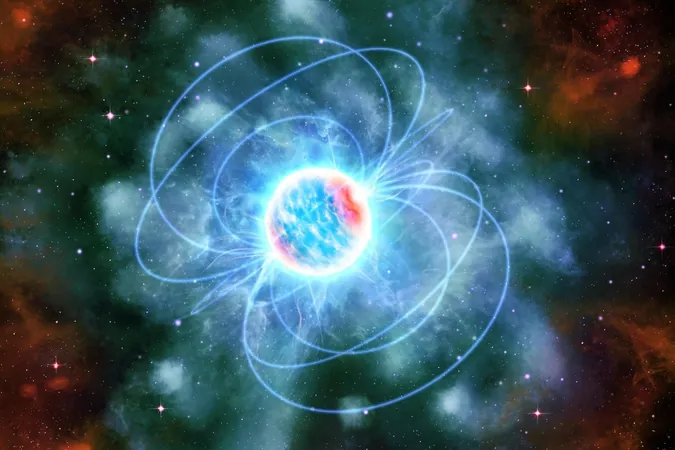
Unveiling a Cosmic First: A Neutron Star Orbiting a Helium Star
2025-05-22
Author: Olivia
Astronomers Discover a Groundbreaking Binary Star System
In a stunning astronomical revelation, scientists have identified a rapidly spinning neutron star locked in a gravitational embrace with a helium star—an extraordinary binary system never seen before. This groundbreaking discovery sheds light on a cosmic phenomenon known as common envelope evolution, a process long theorized but rarely observed.
A Stellar Dance Like No Other
Binary star systems are not uncommon; approximately 85% of stars in the universe exist in pairs. However, this newfound duo breaks the mold. It features a millisecond pulsar—a fast-rotating neutron star that emits pulses of radiation—paired with a helium star. These celestial bodies achieve their remarkable speeds by consuming material from nearby companions.
The Discovery Process Behind This Astounding Find
A team led by Jin Lin Han, a radio astronomer from the National Astronomical Observatories and the Chinese Academy of Sciences, first detected signals from this star in May 2020 using China's FAST radio telescope. By closely monitoring these signals over four and a half years, they discovered that the pulsar is part of a binary system, orbiting its helium companion every 3.6 hours. Interestingly, the pulsar's beam of radiation is eclipsed by the companion for a significant portion of its orbit.
An Unusual Companion Revealed
Data indicated that instead of a typical white dwarf companion, this neutron star was linked to an object with mass akin to our Sun, but undetectable in all wavelengths except radio. This led researchers to deduce that the companion star had likely been stripped of its hydrogen, revealing a core predominantly composed of helium.
A Theoretical Phenomenon in Action
While this rare binary system had been theorized, its physical manifestation represents a significant milestone in astronomical studies. According to Duncan Lorimer, a professor of physics and astronomy at West Virginia University, the common envelope evolution process suggests that a companion star’s massive outer layers can engulf a neutron star, significantly impacting their interactions. This results in a tightly bound system that spirals closer together—a condition achieved in this newly discovered pair.
Future Implications for Astronomical Research
The findings, published in the journal Science, open the door to intriguing questions about the prevalence of such unique systems in the universe. Victoria Kaspi, a professor of physics at McGill University, notes that while such systems might occur in about 1 in 1,000 cases, uncovering one is a groundbreaking achievement.
A Step Forward in Understanding Stellar Evolution
Han and his colleagues suggest that there could be over a dozen similar systems within our galaxy, indicating the rarity and significance of this discovery. As researchers continue to explore the cosmos, each new pulsar found increases the chances of uncovering more extraordinary evolutionary pathways, culminating in a deeper understanding of the universe.









 Brasil (PT)
Brasil (PT)
 Canada (EN)
Canada (EN)
 Chile (ES)
Chile (ES)
 Česko (CS)
Česko (CS)
 대한민국 (KO)
대한민국 (KO)
 España (ES)
España (ES)
 France (FR)
France (FR)
 Hong Kong (EN)
Hong Kong (EN)
 Italia (IT)
Italia (IT)
 日本 (JA)
日本 (JA)
 Magyarország (HU)
Magyarország (HU)
 Norge (NO)
Norge (NO)
 Polska (PL)
Polska (PL)
 Schweiz (DE)
Schweiz (DE)
 Singapore (EN)
Singapore (EN)
 Sverige (SV)
Sverige (SV)
 Suomi (FI)
Suomi (FI)
 Türkiye (TR)
Türkiye (TR)
 الإمارات العربية المتحدة (AR)
الإمارات العربية المتحدة (AR)